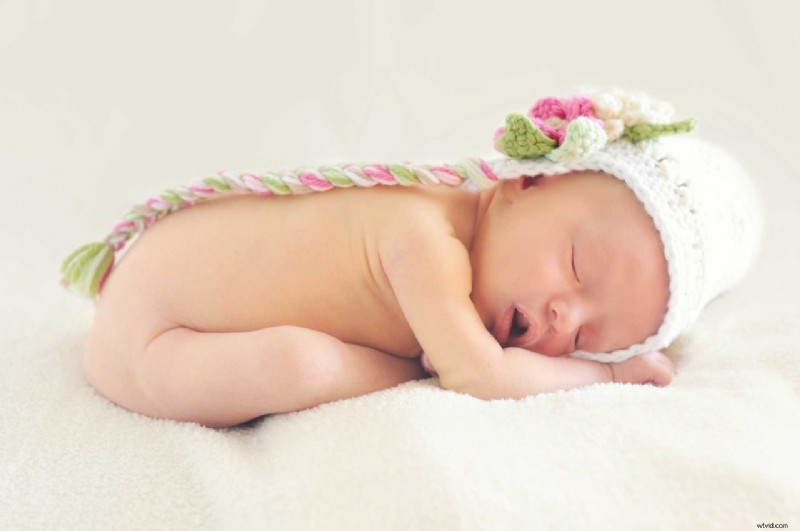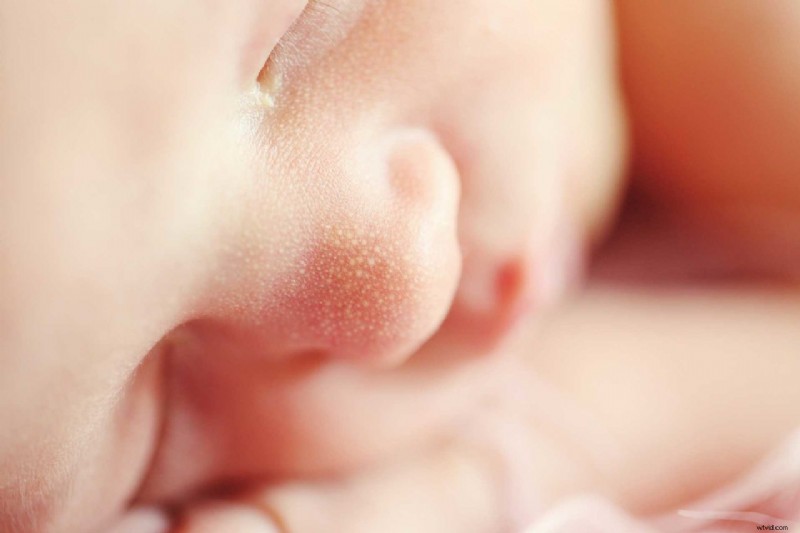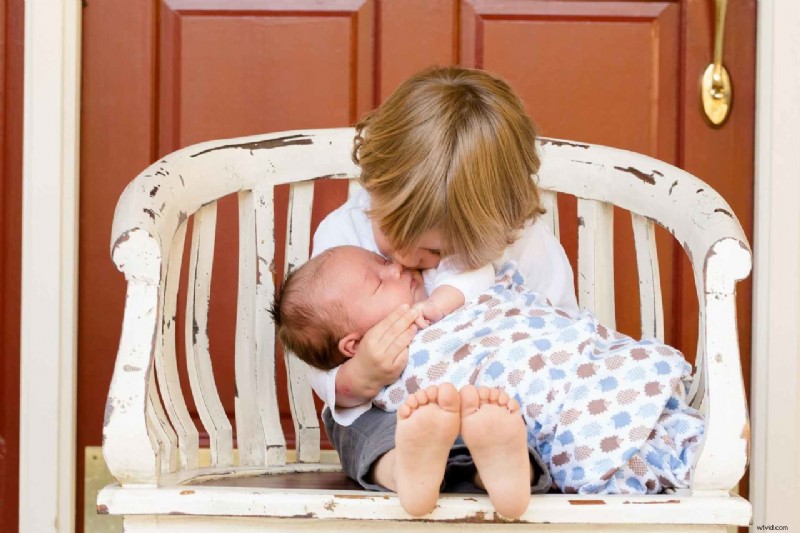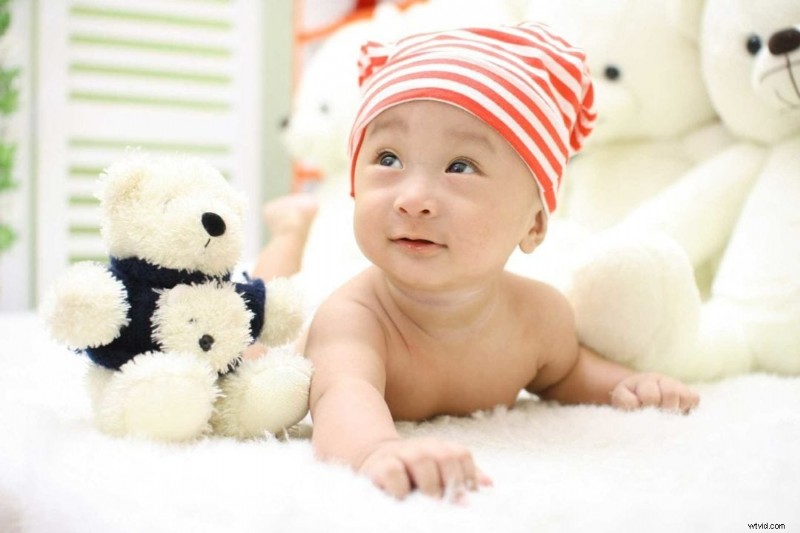Los bebés son probablemente los sujetos más fotografiados del mundo, pero es notoriamente difícil trabajar con ellos. Es virtualmente imposible comunicarle la dirección a un bebé, lo que deja al fotógrafo y al sujeto rápidamente impacientes e irritables. Claro, la fotografía de bebés puede ser muy agradable, pero todos hemos estado en ese punto delicado tambaleándonos por la frustración. ¿No sería bueno renunciar a algo de ese estrés? Con suerte, estos 49 fabulosos consejos y trucos para la fotografía de bebés eliminarán parte de tu tensión.
Consejos de fotografía de bebés para planificar una sesión
Todos somos animales de hábitos, incluidos los bebés. Quizás con la excepción de los recién nacidos, casi todos los bebés estarán acostumbrados a hacer ciertas cosas en ciertos momentos del día. Consulte a los padres para determinar cuándo es probable que el bebé esté más tranquilo e intente disparar durante este tiempo. Si bien esto no es completamente infalible, es probable que aumente sus posibilidades de que un bebé coopere.
Después de determinar a qué hora del día vas a fotografiar, elige una ubicación óptima para fotografiar. En este caso, el tema apunta a fuentes de luz natural. Trate de encontrar un lugar cerca de una ventana o puerta de vidrio, pero tenga en cuenta que la luz, al igual que los bebés, puede cambiar.
Muchas sesiones de recién nacido se realizan sin que el bebé lleve ropa. La piel de los bebés es sensible y su ropa tiende a dejar marcas, por lo que es una buena práctica quitarse la ropa mucho antes de disparar para permitir que la piel del bebé se ajuste.
Si está fotografiando al bebé con la ropa puesta, considere cómo interactúa su atuendo con el fondo sobre el que está fotografiando. ¡Sí, incluso la ropa de bebé puede desentonar!
El tiempo es esencial cuando estás fotografiando bebés. Una estimación generosa sería de 10 minutos de tiempo de disparo. Limpie sus lentes y tenga su equipo a mano antes de que el reloj comience a funcionar para garantizar la máxima cantidad de tiempo con su sujeto.
Si tiene suerte, obtendrá unos 10 minutos de tiempo de grabación con un bebé inquieto. No desperdicie eso limpiando lentes, revisando su bolso en busca de la lente que necesita, etc. Tenga todo lo que necesita, limpio y al alcance de la mano antes de comenzar a disparar.
VER MÁS: 22 consejos de fotografía de recién nacidos que todos los padres deben seguir

El hecho de que su tiempo de grabación real sea pequeño no significa que no deba planificar para lo inesperado. Tenga en cuenta las posibles rabietas, los cambios de pañales, la alimentación, etc. Tómese un amplio margen de tiempo, por si acaso.
Hay un montón de sitios web (Pinterest es un problema) que están repletos de sugerencias de escenarios y poses para fotografiar bebés. Haga uso de estos recursos y léalos con anticipación.
Como hemos dicho en casi todos los puntos hasta ahora, los bebés son temperamentales. Nunca se sabe cuánto durará su estado de ánimo fotogénico, así que asegúrese de tener una lista de las fotos que desea tomar. De esta manera, puede marcarlos a medida que avanza en lugar de perder un tiempo valioso tratando de recordarlos.
Los trípodes definitivamente son útiles para fotografiar bebés porque te dejan las manos libres para posar o distraer al bebé para obtener las expresiones que deseas (para bebés más grandes). Por supuesto, al igual que con el resto de la preparación fotográfica de su bebé, querrá configurar su trípode con anticipación.
Sí, hay una aplicación para eso. No descarte su teléfono inteligente cuando se trata de fotografiar a los más pequeños. Existen varias aplicaciones gratuitas para iOS y Android que reproducirán sonidos divertidos para ayudar a atraer la atención del bebé hacia su lente.
Los sitios web como Etsy cuentan con mercados llenos de vendedores que buscan descargar todo tipo de accesorios adecuados para la fotografía de bebés. Los sombreros, lazos y capullos son algunas de las opciones más populares, pero no tema ser creativo en sus selecciones. Además, siempre puede revender cualquier artículo que compre una vez que haya terminado con ellos.
Hablando de accesorios, no te olvides de las canastas. Le permiten posar a un bebé de una manera práctica y atemporal (piense en recién nacidos o bebés pequeños). Esté atento a los poco profundos que mostrarán bien al bebé. Las tiendas de artículos para el hogar como Homebase o Ikea suelen tener algunos buenos hallazgos. Si no puede encontrar una canasta poco profunda, simplemente cubra el fondo de una normal con toallas, mantas o cojines.
Nuevamente, estamos tratando con la preparación aquí. No querrás que nada se interponga en tu camino para capturar al bebé haciendo algo grandioso. Esta es precisamente la razón por la que debe formatear su tarjeta de memoria antes de cada sesión. Puede estar seguro de que el mejor momento llegará cuando no lo haga.
VER MÁS: 11 toddler photography tips for gorgeous portraits of your child

Baby photography tips for during the shoot
14. Always in raw format
It’s typically always good practice to shoot in raw format, but particularly with babies. If the shots you manage to grab are a bit off you can easily fix them in Photoshop.
15. Experiment with focus points
Traditional “rules” tell us to focus on the eyes, but it certainly doesn’t hurt to break those rules every once in awhile. Try different focal points, such as the baby’s hand or feet while blurring the rest of them, and then go back to the face. Each photo will have a totally different look and will typically work well together as a pair.
16. Keep calm
This one may seem a bit obvious, but it’s important to keep calm during photo shoots with babies. Sure, they can’t communicate with us a traditional way, but they are undoubtedly receptive to our moods and feelings. It’s quite likely that if you’re stressed about the shoot, the baby will be too.
17. Keep quiet
This is where your quiet or silent shooting mode will come in handy. Babies, as we all know, can be easily distracted and even scared by loud beeps and shutter releases. As an alternative, you could play some soothing music to mask your shutter noise.
18. Pick the best aperture
Wide apertures are well-suited for most portraits, including baby shots. Try an f/1.4 or f/1.8, but keep in mind that slight movements of the baby can throw off the focus due to the very shallow depth of field. It might be the case that something a bit narrower such as f/2.8 would better. It’s wide enough to blur the background while at the same time giving you a bit of wiggle room when it comes to slight movements.
19. Keep on shooting
Don’t focus all of your concentration on the formal shoot. Breaks in the shoot due to routine baby care can provide convenient opportunities for impromptu lifestyle shots that show the family interacting with the baby. Try to steer these interactions toward natural light to grab a striking shot.
20. Make a montage
If you follow the advice in the previous step, you’ll end up not just with beautiful posed shots, but all the moments in between. Photos of feedings, changings, and the baby’s things add realism to the posed shots, creating a well-rounded set of images. Turning these photos into a collage or montage will provide a nicely thorough expression of the day’s shoot.
21. Shoot in aperture priority
Since you’ll most likely be using wide apertures for baby portraits, shoot in aperture priority mode to give yourself the freedom to work quickly without having to concern yourself with setting the shutter speed. Select your aperture according to your desired depth of field.
22. Shoot in burst mode
Burst mode is especially convenient if you have an infant on the move. Shooting in this mode will allow you to capture all of the baby’s movements. Silent burst modes are even more optimal as the rapid shutter speed sound can be a little alarming to babies.
23. Bounce the flash
The flash can be very harsh for babies both big and small, but if you find that you absolutely need to use it, use an external flashgun indirectly by bouncing it off the ceiling or an opposite wall. The results will likely be more natural and less interfering.
24. Warm your hands!
It can be easy to forget how sensitive babies are. Be sure to give your hands a good rub to warm them up before touching any bare baby skin. The last thing you want to do is disturb the baby with cold fingers and have to start from scratch.
25. Same pose, different backgrounds
Using the same pose/angle works well for newborns, but it can work for older babies, too. Switching out backgrounds helps create that desired montage look we discussed in tip 21. If you don’t have a background holder, simply attach large pieces of card or material to a wall, or look for a volunteer to hold them up for you.
26. Pick the best lens
As we discussed before, wide apertures and shallow depths of field are perfect for babies. It supplies that wistful, innocent look that’s so well-suited for youth. A good starting lens is a 50mm f/1.8, which can be purchased fairly cheaply. Really anything that opens up wide, such as f/1.4 or f/1.8 will work well.
27. Try out a macro lens
Macro lenses can be surprisingly versatile, allowing you to not only pick out small details on the baby, but they also offer a classic portrait length (such as 60mm or 100mm) and open wide (typically f/2.8).
VER MÁS: Family portrait ideas for people who don’t shoot portraits

28. Don’t lose focus
You probably won’t have much luck convincing a baby to sit perfectly still for a portrait. A fidgety subject means you’ll have to refocus between shots, or switch to continuous AF to keep up with the movements.
29. Bring a change of clothes
Babies can be quite messy, so if you’re shooting somewhere other than its home, make sure to have a spare set of clothes on hand. This is not only practical but also creates some variety in the shots.
30. Reflect the light
Whether or not you use a reflector can have a serious impact on your portrait shots. This is especially true for baby shots because you’re going to want to avoid using artificial light. Some reflectors are composed of several different panels, each creating its own type of light. A white reflector creates neutral, even light, a gold reflector will cast warmer tones, and a silver reflector creates harsh, cold light.
31. DIY Reflector
Reflectors are actually quite easy to make yourself. By covering one side of a large piece of white card with foil, you can create a double sided reflector that’s just as efficient as store-bought one.
32. Choose the best ISO
Shooting a moving baby in natural light means you’re going to need a mid-high ISO to achieve a fast shutter speed. ISO 400 is a good start, but you may need to push it to ISO 800 or 1600 to achieve the focus you want.
Don’t be afraid of a little noise, it’s better than an image that’s out of focus. Set to the top limit of your camera’s automatic ISO (if it has this feature) to save even more time while shooting.
33. Clean up operation
Be prepared for messes with baby wipes. It’s not as easy to remove spots and specks after the shoot in Photoshop as it is to clean the baby in person during the shoot.
34. Focal lengths
Don’t go for that giant lens when you want a close up of the baby. These can be frightening and overwhelming for babies. Best avoid wide angle lenses, too, as these can tend to result in a distorted look.
Instead, make use of longer focal lengths (50mm or above) when you want a close up, and if you’re using a zoom lens, be sure to use the telephoto end.
35. Always be ready
Babies are impulsive and unstructured, and it’s the moments that result from this behavior that you’ll want to capture. Try to increase your chances of doing so by keeping your main camera near the area where you spend the majority of the time with the baby.
If you have another camera on hand, stash it in a part of the house that’s further away from your main camera. This way, you won’t be sprinting across the house when the baby does something amusing.
36. Fast shutter speeds
Newborns typically don’t move all that much, so a slower shutter speed will do. Infants, on the other hand, can be quite squirmy so you’ll want to use a shutter speed of 1/100 or quicker.
37. Focus on the eyes
Babies tend to communicate a lot of emotion through their eyes, so not unlike your other portraits you’ll want to set the focus point to the baby’s eye. If the baby moves you’ll have to refocus.
38. Rosy glow
Bath time typically brings a bright rosy glow to the baby’s face, which is lovely to photograph. A quick rub with the towel will dishevel hair for even more cuteness, and the towel can be used to frame the baby’s face for the shot.
39. Ring the changes
A compilation of images of a baby throughout time can be a nice thing to share with family and friends. Chose one spot in which you’ll photograph the baby every week or so for a year. The changes are sure to be evident.

40. Get down low
Just like you would in other situations, try unusual angles to capture some interesting shots. For instance, put the camera on the floor and point it up at the baby – face or feet, it doesn’t matter! Articulating screens can be particularly useful for framing shots in this case. Just play around with different angles and see what happens!
41. Keep it simple
Toys and baby supplies usually abound wherever the baby is. You don’t want to distract from the baby in the shot, so try to keep your background free of distractions. A stray rattle or teddy bear can peek out from behind the baby and steal the show.
42. Know when to stop
Don’t try to push it when the baby gets irritable or stressed. All you will accomplish is upsetting the baby further, and you really can’t get any good shots anyway when the baby is cranky. Simply take a break and have mum or dad attend to the baby’s needs. They’ll calm down eventually, and then you can start up again.
43. Sentimentality
Sentimental items can make useful props for your baby shoot. Family heirlooms and other emotional items can help make that connection between the baby and older generations of the family. Ask mum or dad, they’ll be sure to have something around.
44. Soft textures
Have the baby lie on a soft rug or blanket. They’ll enjoy the way the texture feels against their skin, and the texture will create a nice background too.
45. Catch the light
Ideally you’ll be shooting near a natural light source, like a window or glass door. You can position the baby so that the light shines down on it from above, creating a catch light in its eyes. This will result in a beautiful, natural illumination in the baby’s face.
46. Toys as props (and distraction)
Most babies older than six months can sit up without help. For these babies, try using toys as props and interactive tools. It’s all about capturing expressions, and a baby is likely to create some great ones if he’s playing with a favourite toy, or maybe even something new!
47. Use the golden hour
When you’re shooting outside, make use of the golden hours. These hours occur right after sunrise and just before sunset. At these times you’ll find your subjects are flooded with natural, flattering golden light.
Make use of the sun’s low position in the sky to create a halo effect around your subject’s head, or maybe add flare for a whimsical look.
48. Get to know them
This step only applies to babies other than your own. Build trust with the baby by spending some time with them before the shoot. Let them get to know you with a little playtime and some cuddling. This way, they’ll be more likely to oblige you when you point a big camera in their face.
49. Different framing options
Traditional rules of composition, such as the rule of thirds, can certainly be helpful in child portraiture, but don’t be afraid to bend and break these guidelines. For instance, try positioning the baby right in the middle of the frame and see how that turns out.
LEER MÁS
25 portrait photography tips for stunning pictures of people
Best camera settings for window-light portraits
Save
Save
Save
